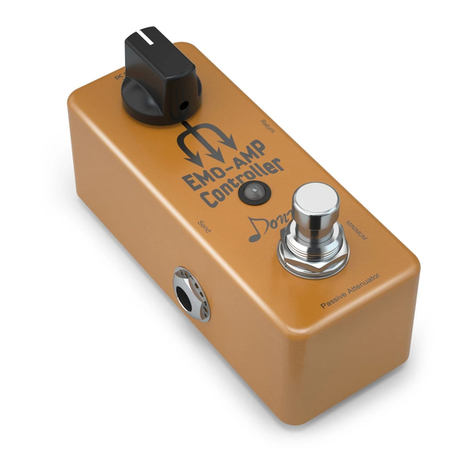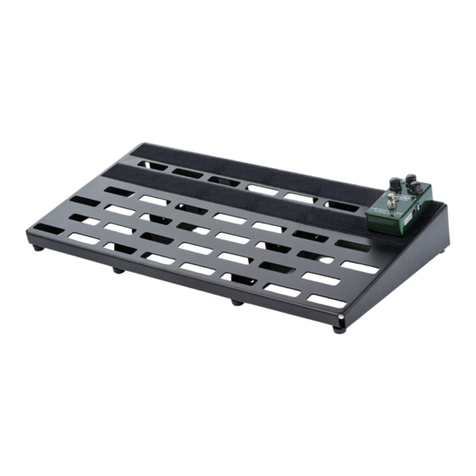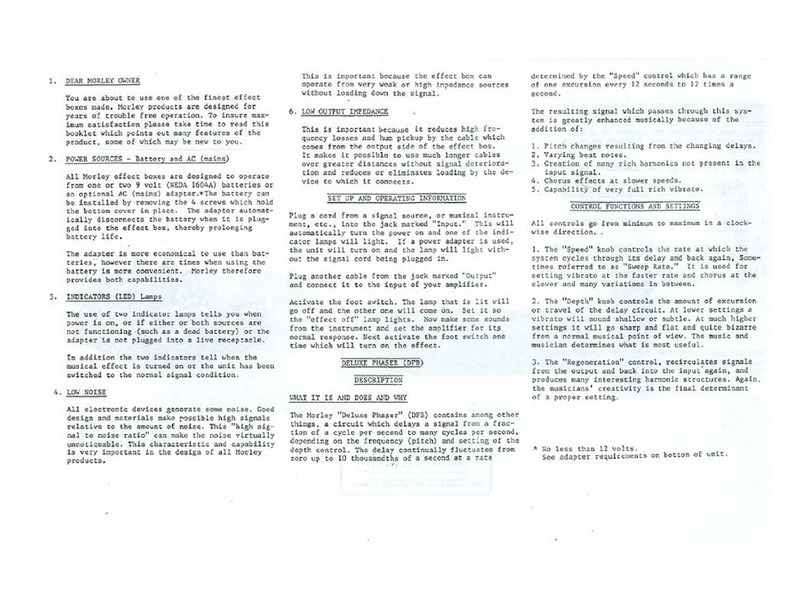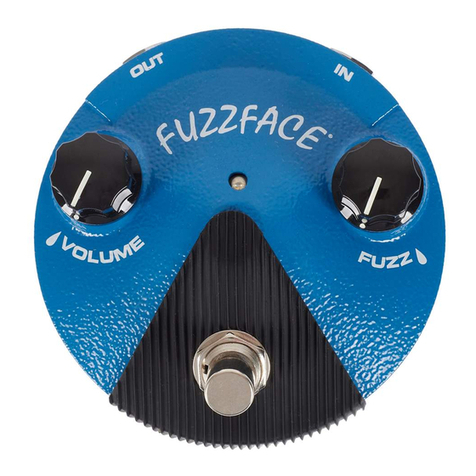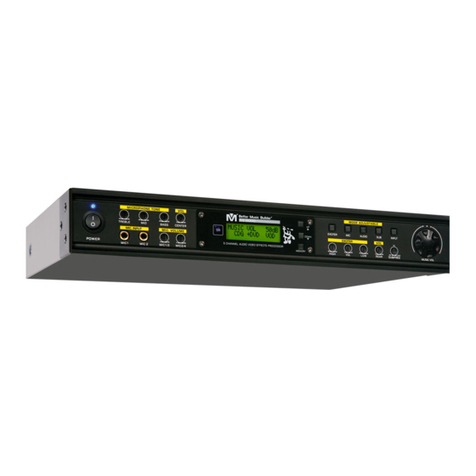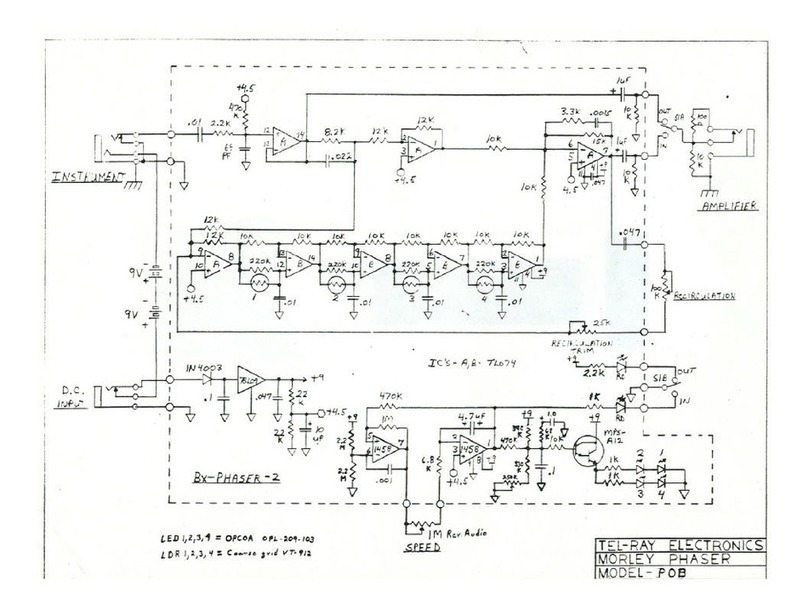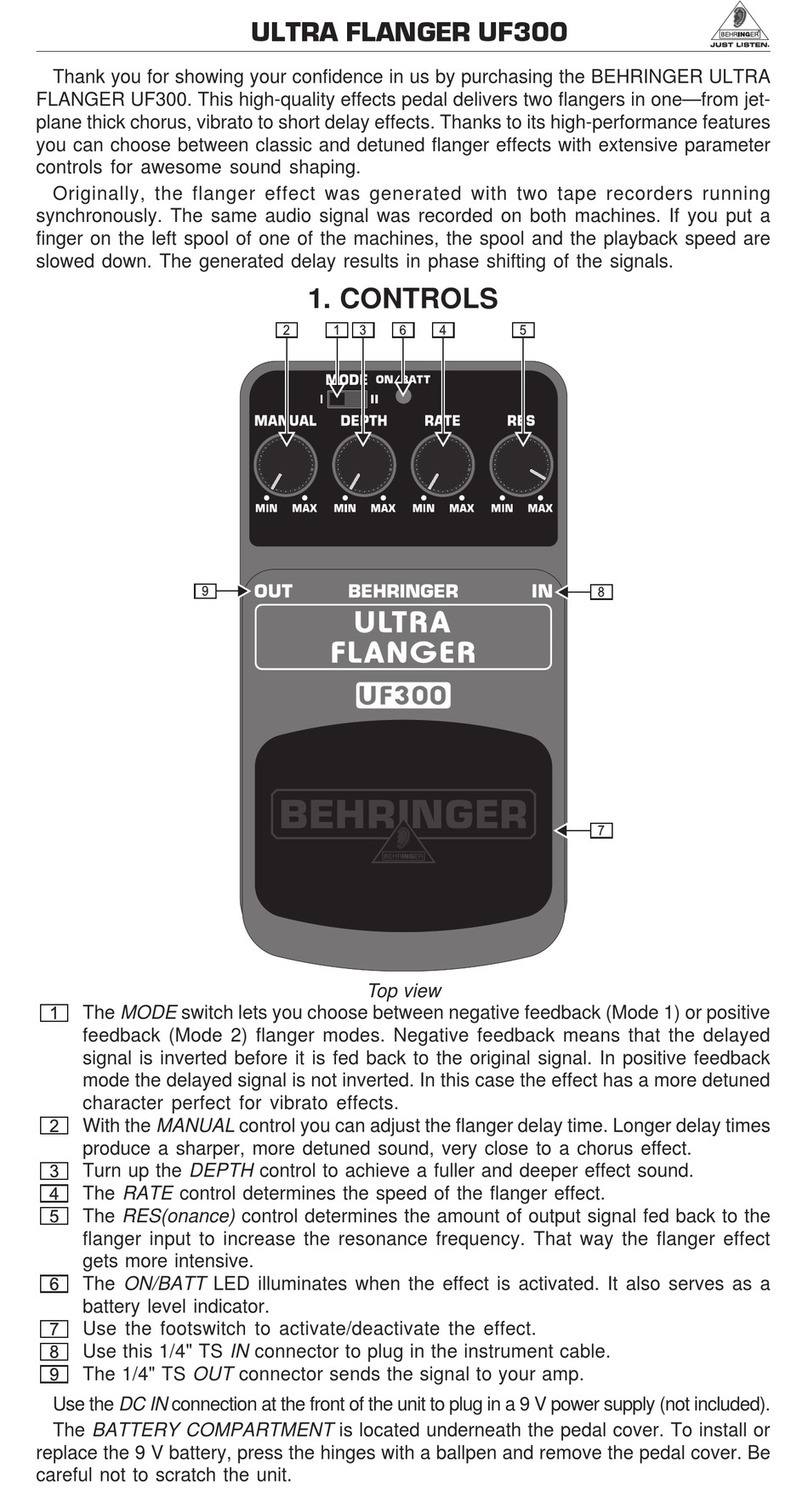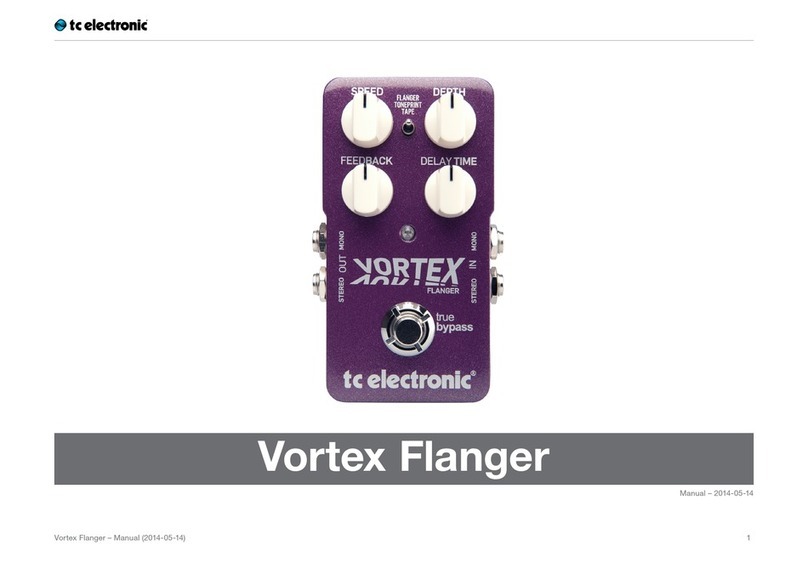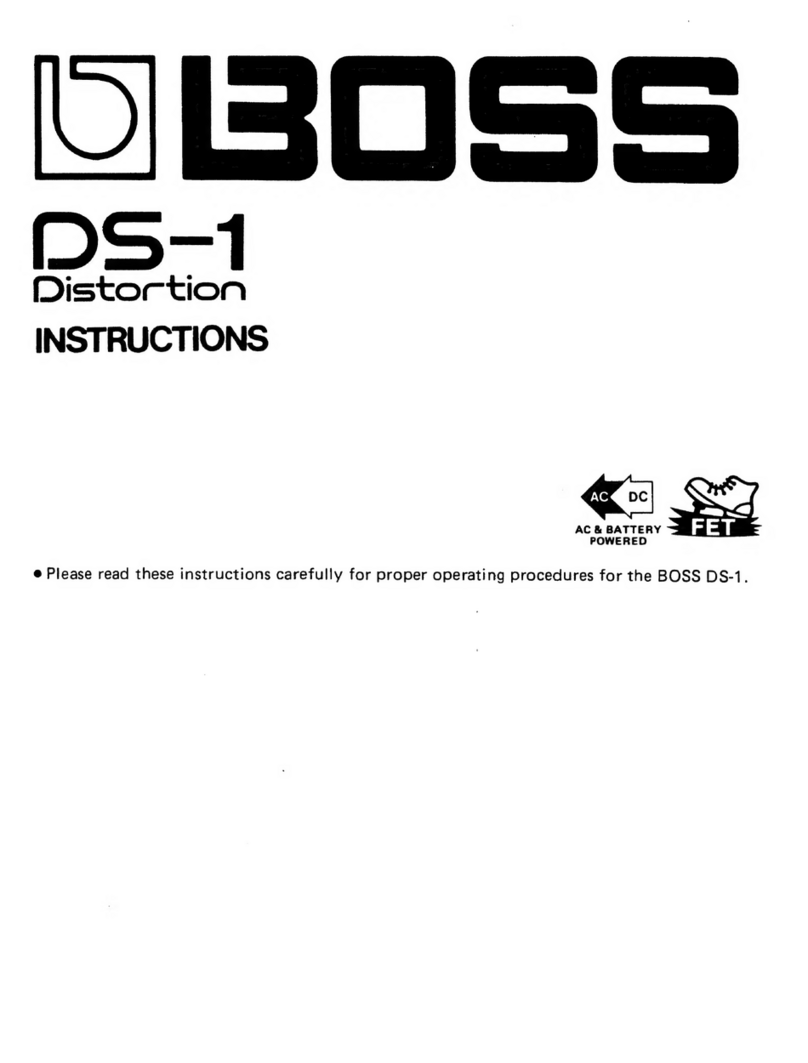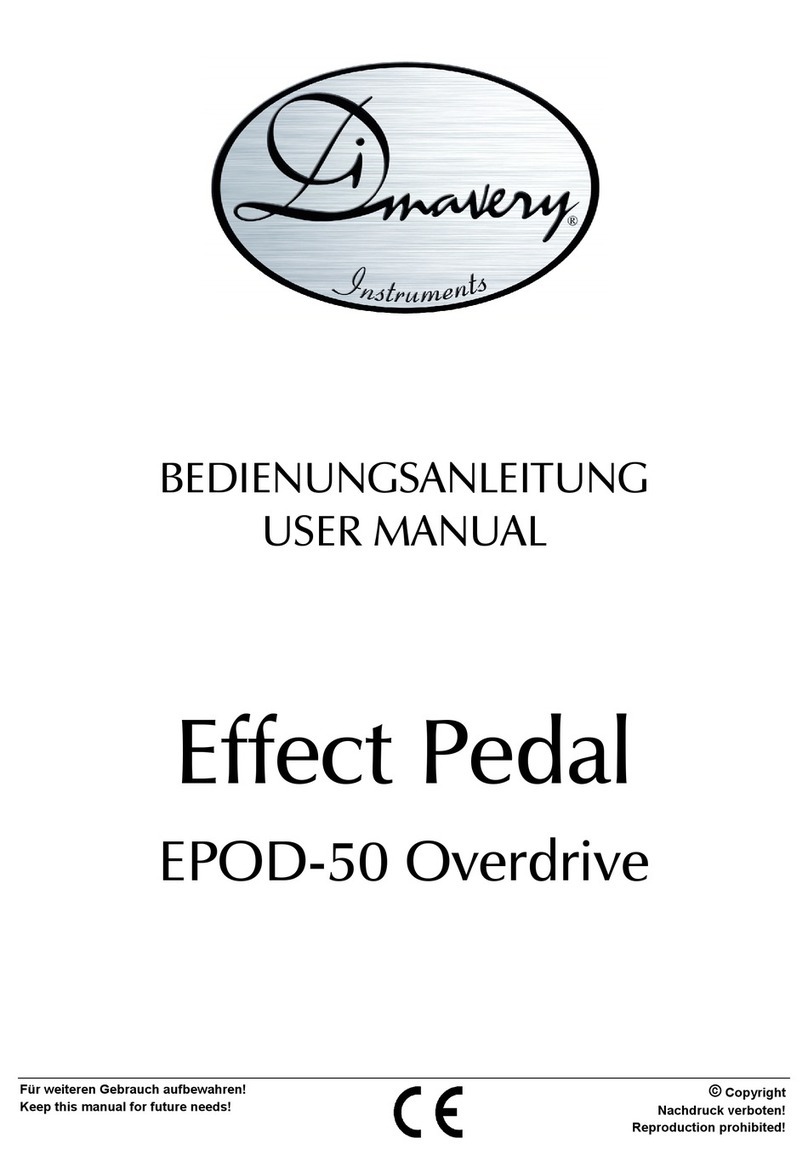Glab MIDI Guitar Controller User manual

Instrukcja obsługi
User Manual
Bedienungsanleitung
MGC-6
Guitar
Controller
Midi


1
Edition 1.0
Table of contents
Table of contents ______________________________________________________ 1
Package content_______________________________________________________ 2
Structure_____________________________________________________________ 3
Diagram of devices connectable to the MGC-6______________________________ 4
Signal’s path diagram __________________________________________________ 5
Preset selection _______________________________________________________ 5
Preset programming ___________________________________________________ 5
Buffer, loops (LOOP 1 to LOOP 6), SWITCH outputs and AUX outputs__________ 6
MIDI program numbers programming _____________________________________ 6
CC Contollers’ value programming _______________________________________ 6
Preset’s storing _______________________________________________________ 7
Preset’s copying ______________________________________________________ 7
Silent tuning __________________________________________________________ 7
Memory access lock ___________________________________________________ 7
SETUP_______________________________________________________________ 8
MIDI INPUT channel number programming_________________________________ 8
Programming of the channel numbers for MIDI Program Change 1, 2, 3_________ 9
Programming of the channel number for Control Change command ___________ 9
CC Controller’s number programming ___________________________________ 10
MIDI OUTPUT mode programming_______________________________________ 10
Bulk memory dump ___________________________________________________ 10
Memory dump permission _____________________________________________ 10
Clearing the presets’ memory___________________________________________ 10
Amp’s control connecting______________________________________________ 11
AUX connectors______________________________________________________ 11
AUX 2xLOOP connection ______________________________________________ 11
AUX A/B SWITCH connection___________________________________________ 12
MIDI specification_____________________________________________________ 13
MIDI Input (MIDI IN)________________________________________________________ 13
Program Change________________________________________________________________ 13
Control Change_________________________________________________________________ 13
System Exclusive (SysEx) type messages___________________________________________ 14
MIDI output (MIDI OUT)_____________________________________________________ 15
System Exclusive dump memory message specification_______________________________ 15
MIDI OUTPUT "Soft Thru" mode ___________________________________________________ 16
MIDI implementation chart__________________________________________________ 17
Errors’ table _________________________________________________________ 17
EMC/EMI & Certificate of conformity _____________________________________ 19

2
Dear Customer,
Congratulations for choosing our G LAB product!
MIDI Guitar Controller (MGC) is the programmable switching device of effects’ loops (looper), the amp’s
switcher and the MIDI devices’ controller in one for rack 19’ systems. MGC-6 can be controlled by any foot
controller or other MIDI device sending the Program Change commands. By choosing one of the presets
MGC-6 enables:
– to activate selected effects (connected to LOOP1 up to LOOP6),
– to set the amp channel (or the pre-amp one) and other amp’s functions controlled by its footswitch
input,
– to set by Program Change command the MIDI device’s program No (at MIDI devices for e.g. effects’
processors) connected to MIDI OUTPUT,
– controlling the additional modules by auxiliary outputs.
Controller enables to store up to 100 presets. Posses the function of presets’ programming and copying.
To avoid accidental presets’ changing controller posses the six level memory protection.
Basic features:
– true passive signal path,
– true bypassed (by electro-mechanical relay), high impedance input buffer,
– the TUNER output with the silent tuning function based on very high impedance circuit (no influence
on a guitar signal) with galvanic separation,
– six TRUE BYPASS loops for connecting effects (using electro-mechanical relays),
– 2 outputs (2 lines each, latching type) for amp's switching by its footswitch input,
– MIDI INPUT to control the MGC by any MIDI controller using the Program Change and Control
Change commands,
– MIDI OUTPUT to control three MIDI devices by Program Change command and one device by
Control Change command for each preset, MIDI OUTPUT can be switched to Soft Thru mode,
– four AUX connectors for connecting additional modules e. g. AB switch, 2XLOOP,
– 19 buttons switching directly particular functions.
Package content
Controller
Power supply adapter
User’s manual

Structure
1 - ON/OFF switch 10 – 13 SWITCH section buttons: 21 - SAVE – store
2 – 9 AUXILIARY section buttons: 10 - SW 1 output switch or in Fun mode digit 9 of the numeric keyboard 22 - shiftbutton
2 - AUX 1 output switch or 11 - SW 2 output switch or in Fun mode digit 0 of the numeric keyboard 23 - ENTER – confirm
in Fun mode digit 1 of the numeric keyboard 12 - SW 3 output switch 24 - ESC – escape
3 - AUX 2 output switch or 13 - SW 4 output switch 25 - LED display
in Fun mode digit 2 of the numeric keyboard 14 – 20 LOOP section buttons: 26 - DOWN decrease
4 - AUX 3 output switch or 14 - BUFFER – on/off buffer switch or 27 - UP – increase
in Fun mode digit 3 of the numeric keyboard in Fun mode MUTE – silent tuning switch 28 - OUT – output signal connector
5 - AUX 4 output switch or 15 - LOOP 1 switch or 29 - LOOP 1 to LOOP 6 – effects’ connectors:
in Fun mode digit 4 of the numeric keyboard in Fun mode MEM PROT. – memory access lock switch RETURN – effect loop input connector,
6 - AUX 5 output switch or 16 - LOOP 2 switch or in Fun mode SETUP switch SEND –- effect loop output connector
in Fun mode digit 5 of the numeric keyboard 17 - LOOP 3 switch or 30 - IN – guitar signal input
7 - AUX 6 output switch or in Fun mode CTRL CHG –controller value switch 31 - TUNER – guitar tuner connector
in Fun mode digit 6 of the numeric keyboard 18 - LOOP 4 switch or 32 - SW1&2, SW3&4 – output connectors to control the amp
8 - AUX 7 output switch or in Fun mode PRG CHG-1 – device 1 Program number switch 33 - AUX 1 to AUX 4 – connectors
in Fun mode digit 7 of the numeric keyboard 19 - LOOP 5 switch or 34 - MIDI IN – MIDI input connector
9 - AUX 8 output switch or in Fun mode PRG CHG-2 – device 2 Program number switch 35 - MIDI OUT – MIDI output or Soft THRU connector
in Fun mode digit 8 of the numeric keyboard 20 - LOOP 6 switch or 36 - 12V DC – Power supply connector
in Fun mode PRG CHG-3 – device 3 Program number switch
3

4
Diagram of devices connectable to the MGC-6

5
Signal’s path diagram
Guitar signal, thru very high impedance (>10 MΩ) tuner buffer and separating transformer, is transmitted to
TUNER output. It enables using of the tuner during playing.
Controller features a switchable (by relay), true bypass input buffer circuit. Buffer which’s input impedance is
consistent with tube amps boost the guitar signal power (without the voltage gain).
Adding the buffer between the guitar and the effect can improve guitar sound (due to their low input
impedance many of the effects change the guitar tone) and in case of using long cables (between the
controller and the amp) it enables to avoid high tones loss caused by cables’ parasitic capacitance appearing
when all the effects are switched off.
SEND outputs should be connected with IN effects inputs and RETURN inputs should be connected with
OUTPUTs of particular effects. MUTE block tunes out the signal during the silent tuning.
Preset selection
Controller enables saving a 100 of presets with numbers from 1 to 100 displayed as P01 to P00 (for preset
No 100). Recalling of the presets can be done by:
– MIDI foot controller by sending Program Change command
– UP, DOWN buttons (by single pressing or pressing and holding)
–by entering the preset number
Preset programming
Preset is defined by:
– switched on effects (connected to LOOP1 to LOOP6) and switched on or off buffer,
– amp’s setting controlled by SW1 to SW4 outputs;
– AUX 1 to AUX 8 outputs’ state
– MIDI Program Change numbers (and Control Change command) transmitted to MIDI devices.

6
Buffer, loops (LOOP 1 to LOOP 6), SWITCH outputs and AUX outputs
In order to switch on or off the buffer, particular effect LOOPs, SWITCH outputs and AUX outputs press the
button placed under the indicator signalising their state. Lighting lamp means: the buffer is switched on, the
effect connected to the loop is switched on, output shorting state of the particular SWITCH and high level
of AUX output.
Lighting of the decimal point after the P letter means that actual preset was modified.
MIDI program numbers programming
MGC-6 enables to control three MIDI devices separately (on different channels set on SETUP function) by
the Program Change commands defined as PRG CHG-1, PRG CHG-2, PRG CHG-3.
Programming no value results in not sending for given preset Program Change command.
CC Contollers’ value programming
Controller enables to send Control Change command with controller No set on SETUP function and with
the value programmed for each preset defined as CTRL CHG.

7
In order to not to send for given preset the Control Change command set the no value.
Preset’s storing
After modifying the preset’s parameters the preset should be saved. Controller enables saving modified
preset under the same preset number or under a different number. Procedure of saving under the same
number is shown below
In case of saving the preset under a different number it is needed to press SAVE button, select the preset
number by using the UP and DOWN buttons or numeric keys and after press the ENTER button.
Protec communicate means that we are trying to store in the protected memory space and that the preset
will not be stored. In such case select other number to store or unlock the memory protection.
Preset’s copying
Controller enables to copy the whole preset. The procedure is similar to preset’s saving. Selecting the
preset No to copy as well as storing could be done by the use of UP, DOWN buttons and also by using the
numeric buttons.
Silent tuning
Controller posses the silent tuning function (MUTE).
Silent tuning mode is signalised by blinking tun text. To exit from this function use one of the following
buttons: ESC, MUTE or ENTER.
Memory access lock
To avoid accidental changes in the programmed before presets controller posses memory access lock
function. This is the six level protection. Information displayed on the LED display means:
Upr – memory unprotected (unlocked)
-20 – presets from 1 up to 20 inclusive locked
-40 – presets from 1 up to 40 inclusive locked
-60 – presets from 1 up to 60 inclusive locked
-80 – presets from 1 up to 80 inclusive locked
ALL – whole memory space locked

8
SETUP
Setup features the following parameters and functions:
- Cin - MIDI input channel number,
- Co1 - MIDI Program Change – 1 channel number,
- Co2 - MIDI Program Change – 2 channel number,
- Co3 - MIDI Program Change – 3 channel number
- Co4 - Control Change channel number
- Cno - CC Controller’s number,
- nio - MIDI output mode
- bdP - Bulk memory dump
- rdP - Memory dump permission
- CEE - Clearing of the presets’ memory
MIDI INPUT channel number programming
The channel number on which MGC-6 receive the Program Change and Control Change commands is
programmable on the Cin position. The available range is from 1 to 16.

9
Programming of the channel numbers for MIDI Program Change 1, 2, 3
Next three positions in Setup defined as Co1, Co2, Co3 enable channel number programming
successively for PRG CHG-1, PRG CHG-2, PRG CHG-3 commands. The available range is from 1 to 16.
Displaying of the rletter with the channel number means that the number of this channel is already
reserved (r) for other Program Change command. Example below shows programming of the channel for
PRG CHG-1. For others proceed analogically.
Programming of the channel number for Control Change command
Channel number for Control Change command is programmed in Co4 function.

10
CC Controller’s number programming
Controller’s No sent to the MIDI device is the same for all of the presets. The available range is from 0 to 127.
MIDI OUTPUT mode programming
MIDI OUTPUT of the controller can be switched on so-called Soft Thru mode. In this mode controller
rewrite in unchanged state data from MIDI INPUT to MIDI OUTPUT. In the Soft Thru mode controller
doesn’t send any Program Change and Control Change commands defined in the presets.
Bulk memory dump
System Exclusive dump memory function enables to make controller’s memory backup. Sending and
receiving System Exclusive dump memory message enables editing the presets and setups on the
computer.
Sending the System Exclusive dump memory message is only possible in out mode of the MIDI OUTPUT.
For more details see “System Exclusive dump memory message specification” chapter.
Memory dump permission
Receiving by controller the System Exclusive dump memory message is possible by setting the controller
on the appropriate mode only. It is signalised by blinking rdP text.
Clearing the presets’ memory
In order to clear the presets’ memory it is needed to enter the password by using the numeric keyboard.
The password is 106. Clearing range can be limited by memory protection function.

11
Amp’s control connecting
The SW1 to SW4 outputs are used to control an amp by its footswitch input. Depending on the features of
your amp they can be used for switching channels, switching on/off reverb or effects loop, BOOST function
or other.
SW1&2 and SW3&4 outputs’ circuit diagram is shown below.
SW1 to SW4 lit indicators mean short-cutting of the adequate relay’s contacts (latching type). This circuit is
separated from the rest of the MGC-6 circuits. It is recommended to use connectors with plastic shielding
to avoid incidental connection with a signal grounding. Lot of amps are equipped with such type of a foot-
switch input so if your amp is equipped with footswitch input connector you should contact your dealer or
the manufacturer of your amp to settle if such type of connection is possible to apply. Depending on an
amp model this connection have to be done using mono or stereo Jack/Jack cable, Y type cable (stereo
Jack – 2 x mono Jack) or need dedicated cable or adapter offered by G LAB. The actual list of available
cables and adapters you’ll find at www.glab.com.pl If you don’t find on our site the cable you need please
AUX connectors
MGC-6 has four AUX connectors for additional modules to extend the controller’s functionality e.g.
AUX A/B SWITCH or AUX 2xLOOP. The actual list of modules you’ll find in accessories for the controller
at www.glab.com.pl.
Single AUX output circuit diagram is shown below.
AUX 2xLOOP connection
AUX 2xLOOP enables controlling by MGC-6 two additional effect loops connected for e.g. to an amp
effects loop or between OUT output and amp input. Looper has passive signal path and true bypass circuit
for switched off effects.
Connection of the devices should be done by using the cable supplied to the AUX 2 x LOOP. With this
cable we connect AUX IN connector of the AUX 2xLOOP with one of the AUX1-4 connectors of the MGC-

12
6. For switching the loops serve the corresponding buttons of AUXILIARY SECTION (for AUX 1 buttons 1
and 2, for AUX 2 buttons 3 and 4, AUX 3 buttons 5 and 6 and for AUX 4 buttons 7 and 8).
It is possible to connect four AUX 2xLOOPs to one MGC-6 maximally.
Below you will find the example of AUX 2 X LOOP connection.
Extending the MGC by two effect loops.
Two stereo effects switch (TRUE BYPASS)
AUX A/B SWITCH connection
AUX A/B SWITCH enables switching two different signal sources to one OUTPUT. Connection of the
devices should be done by the cable supplied to AUX A/B SWITCH. With this cable we connect AUX IN
AUX A/B SWITCH connector with one of the AUX1-4 connectors of the MGC-6. For switching the AUX A/B
SWITCH serve the corresponding button of AUXILIARY SECTION.
It is possible to connect the second AUX A/B SWITCH to the one already connected to the MGC-6.

13
Below you will find the example of the AUX A/B SWITCH connection.
Guitar switch
MIDI specification
MIDI Input (MIDI IN)
Controller can attend following commands:
Program Change
Sent value Program number Function
0 - 99 1 – 100 Preset number
100 101 mute ON
Control Change
Controller’s number Controller’s value Function
0-63 AUX1 switching off
20 64-127 AUX1 switching on
0-63 AUX2 switching off
21 64-127 AUX2 switching on
0-63 AUX3 switching off
22 64-127 AUX3 switching on
0-63 AUX4 switching off
23 64-127 AUX4 switching on
0-63 AUX5 switching off
24 64-127 AUX5 switching on

14
Controller’s number Controller’s value Function
0-63 AUX6 switching off
25 64-127 AUX6 switching on
0-63 AUX7 switching off
26 64-127 AUX7 switching on
0-63 AUX8 switching off
27 64-127 AUX8 switching on
0-63 Switch1 switching off
28 64-127 Switch1 switching on
0-63 Switch2 switching off
29 64-127 Switch2 switching on
0-63 Switch3 switching off
30 64-127 Switch3 switching on
0-63 Switch4 switching off
31 64-127 Switch4 switching on
0-63 LOOP1 switching off
52 64-127 LOOP1 switching on
0-63 LOOP2 switching off
53 64-127 LOOP2 switching on
0-63 LOOP3 switching off
54 64-127 LOOP3 switching on
0-63 LOOP4 switching off
55 64-127 LOOP4 switching on
0-63 LOOP5 switching off
56 64-127 LOOP5 switching on
0-63 LOOP6 switching off
57 64-127 LOOP6 switching on
0-63 BUFFER switching off
58 64-127 BUFFER switching on
0-63 LDR S * switching off
59 64-127 LDR S * switching on
0-63 LDR R * switching off
60 64-127 LDR R * switching on
0 Mute ON
71-127 Mute OFF
* - for production tests only
System Exclusive (SysEx) type messages
Controller attend two messages SysEx type related to resending and receiving presets and setup memory
content.
F0 00 20 71 14 01 01 F7 – message in this format is interpreted as memory content resending request.
After receiving it the message with memory content is sent out (for more information see System Exclusive
dump memory message specification chapter).

15
F0 00 20 71 14 01 00 ... - message in this format is interpreted as memory content. If controller is set on
mode enabling to receive this message the data will be received and the whole preset and setup memory
will be overwritten.
MIDI output (MIDI OUT)
Every of 100 presets can send one Control Change and three Program Change commands. For Control
Change command the controller’s number is common for all the presets. Commands are sent each time
after selecting the preset. Successively are sent Program Change 3, Program Change 2, Program Change
1 and Control Change commands.
System Exclusive dump memory message specification
Controller attend one SysEx type message containing presets and setup memory data (memory dump). It
enables to save memory backups and editing presets and setup on the computer. It is possible to copy the
memory from one to another MGC. Sending out the memory contain can be recalled manually in bdp
function (in controller’s SETUP) or remotely by MIDI request message.
Memory contain message specification:
1) First byte 0xF0 - SysEx Start
2) Three bytes G LAB ID ( 0x00 0x20 0x71)
3) SysEx message channel (14h)
4) One byte device ID MGC-6 1.xx (01h)
5) Message statute byte (00h – data to store)
6) 101 frames with memory contain
MIDI specification is expected to send data with cleared eighth bite. Because of that the data is packed in
eight or three data bytes in given way: seven bytes with MSB=0 + eighth with MSBs or two bytes + third as
on the scheme below.
Memory frame containing 16 bytes is sent as a frame with 8+8+3 MIDI data bytes.
First frame contains the general information about the controller and its setup in following order:
a) 3 data signature bytes (03h , 05h , 09h)
b) 1 reserved data byte
c) 1 data byte with the input channel number (range 1-16)
d) 1 data byte with the output channel number for the Program Change 1 (range 1-16)

16
e) 1 data byte with the output channel number for the Program Change 2 (range 1-16)
f) 1 data byte with the output channel number for the Program Change 3 (range 1-16)
g) 1 data byte with the output channel number for the Control Change (range 1-16)
h) 1 data byte with the information about the memory access lock state
(1 - "UnP", 2 - "-20", 3 – "-40", 4 - "-60", 5 - "-80", 6 - "All")
i) 1 data byte with the controller’s number for Control Change
(range 1-128 interpreted as 0-127)
j) 1 byte with the information about the MIDI output mode (0 – out , 1 - thru)
k) 4 reserved data bytes
Next 100 frames contains the information about the presets:
a) 1 byte with the information about the AUXILIARY OUTPUTs state according to the scheme
below
A1 - A8 – AUXILIARY 1 - AUXILIARY 8
b) 1 byte with the information about the SWITCH OUTPUTs state according to the scheme
below
S1 – S4 - SWITCH 1 – SWITCH 4, X – reserved
c) 1 byte with the information about the LOOPs state according to the scheme below
L1 – L6 - LOOP1 – LOOP6, B – BUFFER, X - reserved
d) 1 byte with Program Change 1 value (range 1 – 128, 0 = not sent)
e) 1 byte with Program Change 2 value (range 1 – 128, 0 = not sent)
f) 1 byte with Program Change 3 value (range 1 – 128, 0 = not sent)
g) 1 byte with controller’s Control Change command value
(range 1 – 128 interpreted as 0 =not sent and 0 – 127)
h) 9 reserved bytes
Next 27 frames contains reserved data bytes.
7) F7 – Sysex end byte
MIDI OUTPUT "Soft Thru" mode
Controller’s output can be set on so-called Soft Thru mode. On this mode data received by MIDI input are
sent in unchanged state by output. On this mode the controller doesn’t send neither commands
programmed within the presets’ frame nor the special message dump memory.

17
MIDI implementation chart
G LAB MIDI Guitar Controller MGC-6 rev. 1.01 01.10.2008
Function Transmitted Recognised
Basic Channel
Default 1,2,3,4 1
Changed 1-16 1-16
Mode
Default
Messages X X
Altered
Note Number XX
True Voice X X
Velocity
Note ON X X
Note OFF X X
After Touch
Keys X X
Channels X X
Pitch Bend XX
Control Change 0 -127 7, 20-31, 52-61
Prog Change 1-128 1-101
System Excl. OO
System Common
Song Pos X X
Song Sel X X
Tune X X
System real time
Clock X X
Commands X X
Aux Messages
Local ON/OFF X X
All Notes OFF X X
Active Sense X X
Reset X X
O: YES
X: NO
Errors’ table
The table below shows the list of errors displayed by controller with their description and solving
procedure.
Error1 Memory EEPROM error – contact your dealer
Error2 Disable to send SysEx memory dump message – set MIDI OUT on out mode
Error3 Entered wrong password – enter 106

18
This manual suits for next models
1
Table of contents
Other Glab Music Pedal manuals
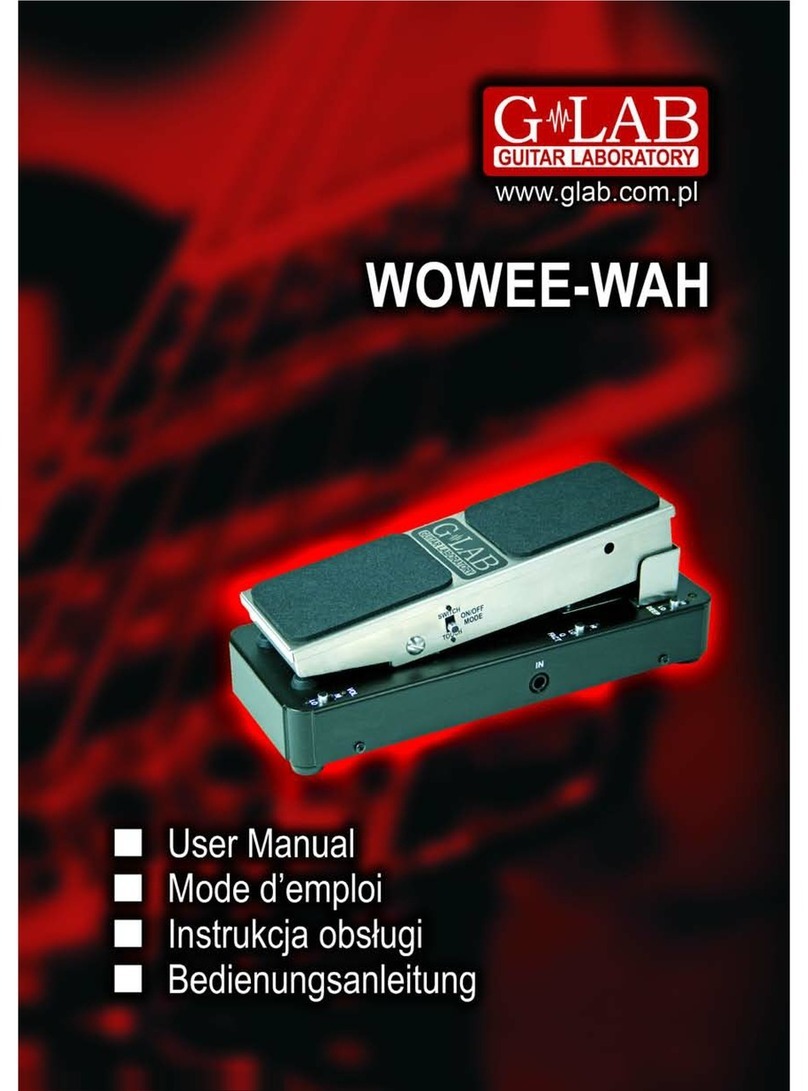
Glab
Glab WoWEE-WAH User manual
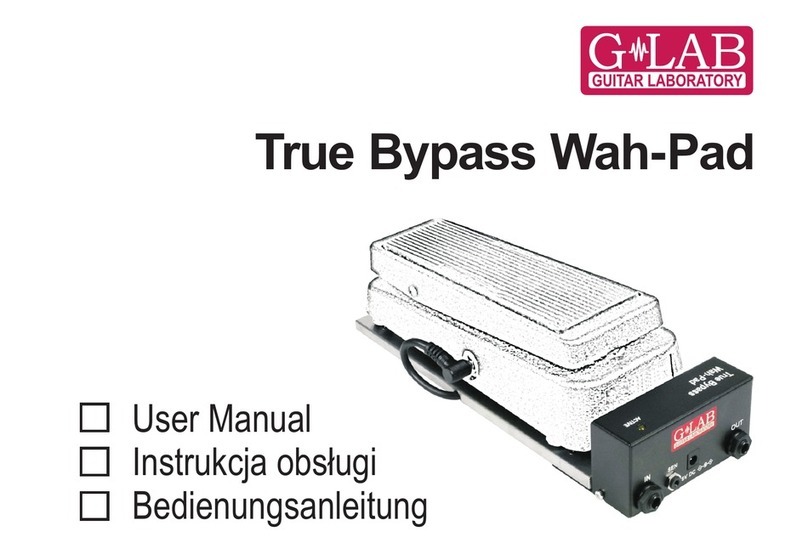
Glab
Glab True Bypass Wah-Pad User manual

Glab
Glab True Bypass Wah-Pad User manual
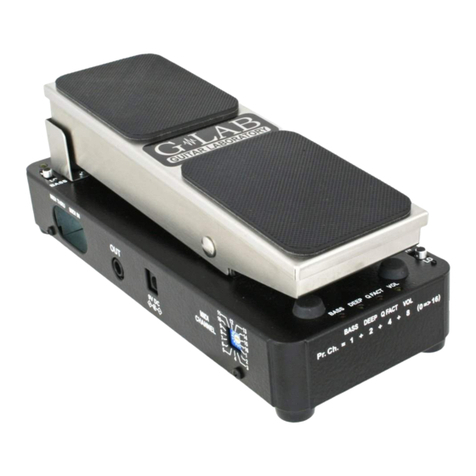
Glab
Glab WoWEE-WAH User manual
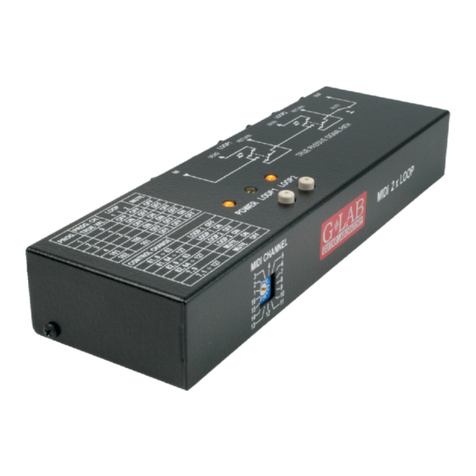
Glab
Glab Midi 2 x Loop User manual
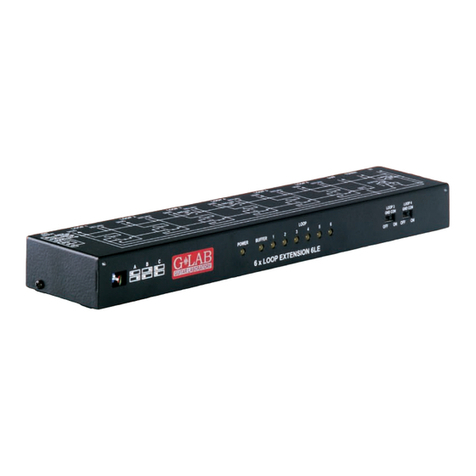
Glab
Glab 6 x LOOP EXTENSION User manual
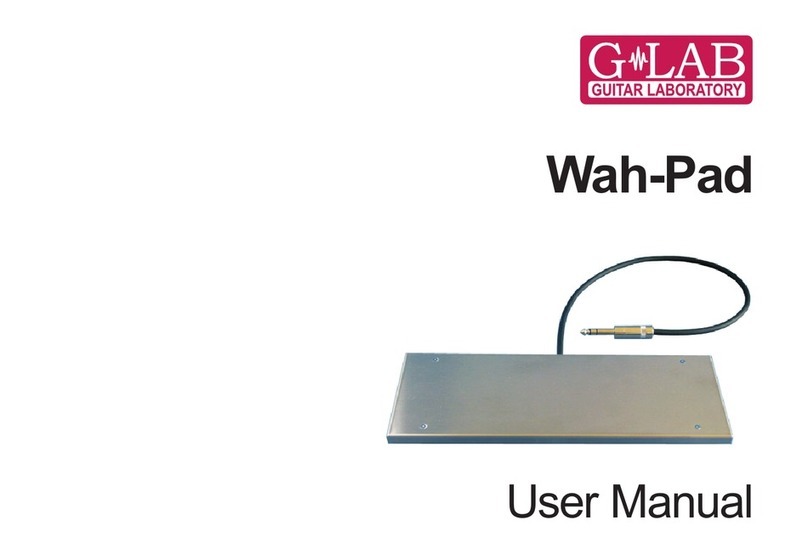
Glab
Glab Wah-Pad User manual

Glab
Glab Dual Vintage Overdrive User manual
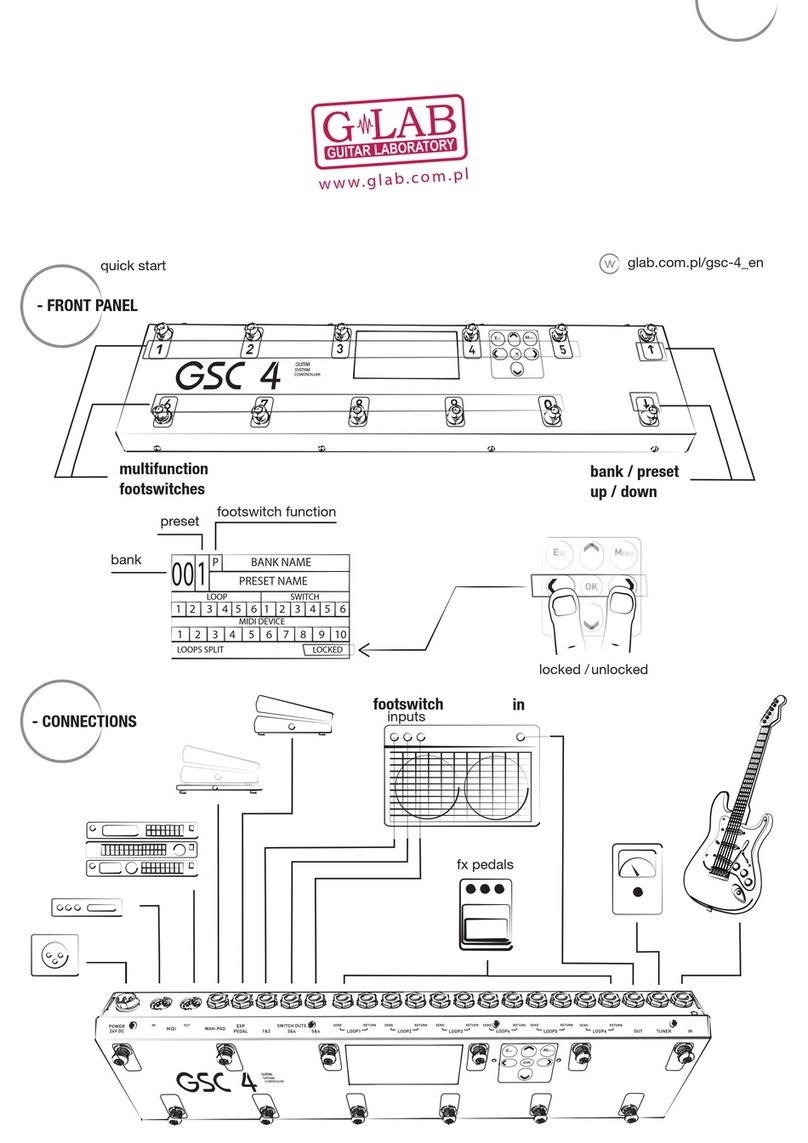
Glab
Glab GSC-4 User manual
